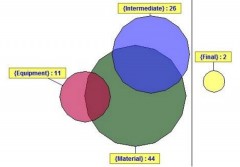What can web scraping reveal about the commercialization of graphene? That’s the question Philip Shapira, Abdullah Gök and Fatemeh Salehi Yazdi have set out to answer using a mixture of computerized data mining and other analytical techniques.
The team, based at Manchester Business School, has chosen graphene as a ‘demonstrator’ to road-test its approach, which identifies patterns from publicly available information hosted on enterprise websites. The hope is that these methods can assist in providing ‘real-time intelligence’ to map the development of rapidly emerging materials and technologies.
In the pilot study, Shapira and his colleagues have focused on a set of 65 graphene-based small and medium-sized enterprises (SMEs) based in 16 different countries – 49.2% of the SMEs in the sample are located in North America, 15.4% in the UK, 18.5% in Western Europe and 16.9% in East Asia and emerging nations. The researchers acknowledge that they haven’t captured every graphene SME in every country, particularly in China, and note this under-representation should be kept in mind when comparing across the regions.
Presenting their findings in a Nesta working paper, the authors draw attention to the following –
- Access to finance and the firms’ location are significant factors that are associated with graphene product introductions.
- Patents and scientific publications are not statistically significant predictors of product development in their sample of graphene SMEs.
- Graphene SMEs are focusing mainly on upstream and intermediate offerings in the value chain.

Relationship between different value chain positions – [equipment:11] [material:44] [intermediate:26] [final:2] – of SMEs in the study. Credit: Nesta Working Paper 15/14
Graphene advantage?
According to the data, the mention of other 2D materials on a company website turned out to be a significantly negative predictor of introducing a product into the market. “In other words, focusing on graphene was more likely to be associated with a product introduction – perhaps because other 2D materials are as yet further away from being ready for the market or because focusing on multiple materials in a resource-constrained SME might diffuse or slow down commercialisation capabilities,” comment the authors in their work.
Supporting movement up the value chain
As the researchers note, currently there is an emphasis in SMEs on producing advanced graphene materials, although many are signalling plans to develop more intermediate graphene products that should have higher value in the marketplace. Technology intermediary organisations are likely to be important in supporting these next stages of graphene development – examples include the UK National Graphene Institute, which opened in March this year, and its sister facility the Graphene Engineering Innovation Centre, which is planned for completion in 2017.
Full details
Graphene Research and Enterprise: Mapping Innovation and Business Growth in a Strategic Emerging Technology
Philip Shapira, Abdullah Gök and Fatemeh Salehi Yazdi – Nesta Working Paper No15/14, August 2015
Further reading in the journal Translational Materials Research (TMR)
Graphene Connect underscores the importance of engaging SMEs in materials commercialization
Sizing up your innovation ecosystem
Related stories on TMR+
$5 million investment in Angstron Materials accelerates graphene commercialization
Graphene Week 2015: industry opportunities and more
Elsewhere on the web
Graphene booms in factories but lacks a killer app (Nature news)
